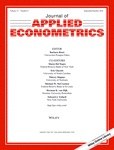
Koopman, S. and Creal, D. (2010). Extracting a robust U.S. business cycle using a time-varying multivariate model-based bandpass filter Journal of Applied Econometrics, 25:695--719.
-
Affiliated author
-
Publication year2010
-
JournalJournal of Applied Econometrics
We develop a flexible business cycle indicator that accounts for potential time variation in macroeconomic variables. The coincident economic indicator is based on a multivariate trend cycle decomposition model and is constructed from a moderate set of US macroeconomic time series. In particular, we consider an unobserved components time series model with a common cycle that is shared across different time series but adjusted for phase shift and amplitude. The extracted cycle can be interpreted as a model-based bandpass filter and is designed to emphasize the business cycle frequencies that are of interest to applied researchers and policymakers. Stochastic volatility processes and mixture distributions for the irregular components and the common cycle disturbances enable us to account for the heteroskedasticity present in the data. Forecasting results are presented for a set of different specifications. Point forecasts from the preferred model indicate a future recession with the uncertainty over the business cycle growing quickly as the forecast horizon increases. {\textcopyright} 2010 John Wiley \& Sons, Ltd.